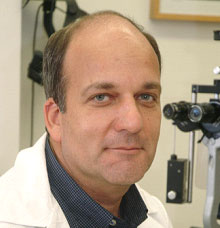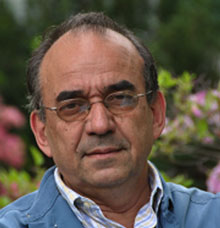Symposium on Stem Cell Therapies: From Degeneration to Regeneration
Speakers

Eyal Banin
Hdassah-Hebrew University Medical Center
banine@cc.huji.ac.il
Directed differentiation of human embryonic stem cells into functional retinal pigment epithelium cells
Dysfunction and loss of retinal pigment epithelium (RPE) leads to degeneration of photoreceptors in age-related macular degeneration and subtypes of retinitis pigmentosa. Human embryonic stem cells (hESCs) may serve as an unlimited source for the derivation of RPE cells suitable for transplantation in these blinding conditions. Using defined culture conditions, we were able to promote directed differentiation of hESCs toward an RPE fate. In the presence of nicotinamide, differentiation of hESCs to neural and subsequently to an RPE fate is augmented. This is further improved when factors from the TGF-b superfamily, which presumably pattern RPE development during embryogenesis, are introduced. The hESC-derived pigmented cells exhibit the morphology, marker expression, and function of authentic RPE and rescue retinal structure and function after transplantation in an animal model of retinal degeneration caused by RPE dysfunction. These results may serve as an important step towards the future use of hESCs to replenish and support failing RPE in blinding diseases.

Peter Coffey
University College London
p.coffey@ucl.ac.uk
Stemming Vision Loss using Stem Cells
The London Project to Cure Blindness aims to make the most of human embryonic stem cells to prevent blindness and restore sight in patients with age-related macular degeneration (AMD) by 2012. Our goal is to replace cells essential for "seeing" lost by disease at the back of the eye. We aim to repair and regenerate the aged diseased eye using human embryonic stem cells which have been transformed into the cells affected in AMD: the support cells for the photoreceptors (retinal pigment epithelium) and the photoreceptors. The cells will be surgically implanted into a clinical population of AMD patients.

Thomas Reh
University of Washington
tomreh@u.washington.edu
Stem Cell Approaches for the Treatment of Retinal Diseases
The generation of human embryonic stem cell lines and, more recently, induced pluripotent stem cells, has led to new possibilities for the treatment of retinal diseases. We have developed protocols for the directed differentiation of embryonic stem cells and iPS cells to retinal cell fates, including rod and cone photoreceptors. We have also found that the photoreceptors derived from human ES cells can potentially provide a source for cell replacement in animal models of retinal diseases: retinal cells derived from human ES cell lines or iPS cells can integrate with the host retina, even when transplanted into mature mice, or those with retinal degeneration. In addition, the production of retinal cells from iPS cells derived from patients with retinal diseases makes possible new types of disease models. The challenge now is to translate these basic science findings to clinical application. In this presentation, I will review our progress in the development of stem cell therapy in the retina.

Ronald McKay
National Institute of Neurological Disorders and Stroke, National Institutes of Health
RonMcCay@ninds.nih.gov
Controlling Stem Cells in Health and Disease
The work in our group is focused on the biology of stem cells and neuronal death. The generation and differentiation of human pluripotent stem cells opens new perspectives in human genetics. We have shown that in defined conditions, human ES and iPS cells have a standard transcriptome providing a strong basis for any future work using these cells. The implications of this finding for human genetics is being pursued. This work also provides new insight into the first steps regulating the differentiation of pluripotent cells. We are most interested in the events that specify dopamine neurons. By genetic lineage tracing we showed that the Foxa2 gene was responsible for the initial specification of dopamine neurons in vitro and in vivo. This knowledge of early development provides new approaches to the differentiation of human ES and iPS cells to dopamine neurons in vitro.
Analysis of the role of the Foxa2 gene also gives new insight into the long-term survival of dopamine neurons in the adult brain. In our analysis of the development of dopamine neurons, we recognized that haploinsufficient (Foxa2 +/-) animals spontaneously developed abnormal motor behaviors. In animals with low levels of this protein, dopamine neurons in the midbrain are lost with pathological features that are similar to the pathology seen in patients with Parkinson's disease (PD). Notably, the onset of the disease occurs late in life and the initial loss of neurons is asymmetric. Foxa2 is a member of the Foxo gene family. This group of genes plays a central role in cell survival and the longevity of organisms. We are currently studying the signaling pathways that link upstream regulators to dopamine neuron survival. In collaboration with a human genetics group, we established the first link between FGF20 and PD. Subsequent work has confirmed this association in both Caucasian and Asian populations. It is now clear that the mutation conferring risk is in the 3' untranslated region of the gene in what is very likely a miRNA binding site. This work also opens up new approaches to controlling the survival of dopamine neurons.
Although transplantation of neural stem cells or their differentiated progeny is a possible therapeutic benefit of stem cell biology, our in vivo studies suggest an alternate strategy. We have shown that increasing the numbers of endogeneous stem cells promotes the survival of injured neurons and confers behavioral improvements in models of both ischemic stroke and Parkinson's disease. This work suggests a strategy to pharmacologically enhance brain repair by targeting endogenous stem cells. The idea that neural stem cells and neurons are intimately linked may provide general strategies to promote recovery from degenerative disease.

